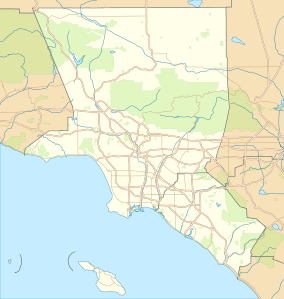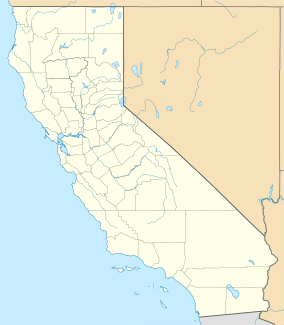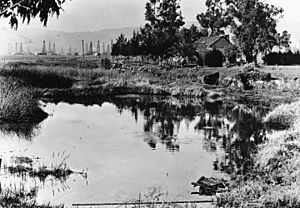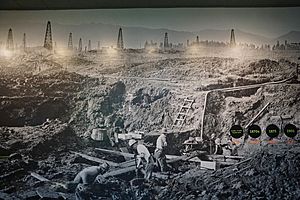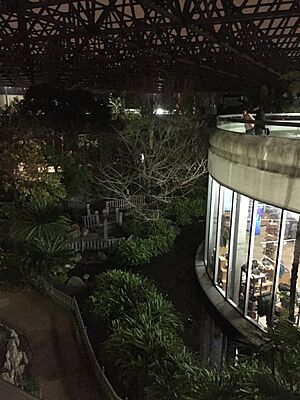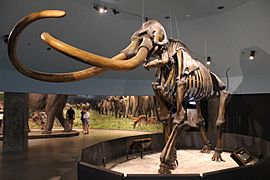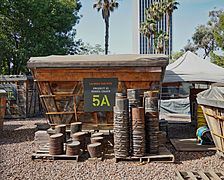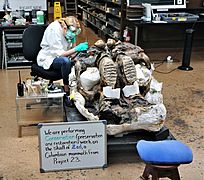La Brea Tar Pits facts for kids
Quick facts for kids La Brea Tar Pits |
|
|---|---|

Methane gas bubble emerging at La Brea Tar Pits (2004)
|
|
| Location | Hancock Park, Los Angeles, US |
| Official name: Hancock Park La Brea | |
| Reference #: | 170 |
| Designated: | 1964 |
The La Brea Tar Pits are a famous place in Los Angeles, California. Here, natural sticky tar (also called asphalt or bitumen) has been bubbling up from the ground for thousands of years. This sticky tar has trapped many animals over time. Their bones have been perfectly preserved, giving us a peek into the past.
The Hancock Park was created around these tar pits. Today, the George C. Page Museum is right next to the pits. It's a special place where scientists study the fossils found here. The museum also shows off amazing skeletons of animals that got stuck long ago. The La Brea Tar Pits are so important that they are a registered National Natural Landmark.
Contents
How Tar Pits Formed
Tar pits are made of thick, heavy oil that slowly seeps out of the ground. This oil comes from deep underground, along a crack in the earth called the 6th Street Fault. When the oil reaches the surface, it forms pools. Over time, the lighter parts of the oil evaporate or break down. This leaves behind the thick, sticky asphalt we call tar.
Sometimes, this asphalt hardens into small mounds. But for thousands of years, it also formed deep, gooey traps. Water, dust, and leaves would cover these sticky pools, hiding the danger. Animals would wander in, get stuck, and couldn't escape.
Often, bigger animals like saber-toothed cats or dire wolves would come to hunt the trapped animals. But then, they would get stuck themselves! This is called a "predator trap." As an animal's bones sank into the tar, the asphalt would soak into them, turning them dark brown or black. The tar then hardened around the bones, keeping them safe for thousands of years.
Scientists have found not just big animal bones, but also tiny fossils. These include pieces of wood, plants, small rodent bones, insects, and even pollen. The oldest things found here are about 38,000 years old!
A Look Back in Time
Long ago, native people like the Chumash and Tongva used the tar from these pits. They used it to seal their wooden boats, called Tomols. This helped them travel along the California coast.
The first Europeans to see the tar pits were Spanish explorers in 1769. Father Juan Crespí wrote about "geysers of tar" bubbling from the ground. He called them "Los Volcanes de Brea," meaning "the Tar Volcanoes."
Later, in 1826, an explorer named Harrison Rogers saw the hardened tar. He noted that people used it to waterproof the roofs of their houses. The land where the tar pits are was once part of a large ranch called Rancho La Brea. The ranch owner made sure the tar pits were open for everyone to use.
At first, people didn't realize the bones in the pits were ancient fossils. They thought they were just bones from ranch animals that had gotten stuck. But soon, scientists understood how special these discoveries were.
Digging Up the Past
In 1901, a geologist named W. W. Orcutt was the first to realize that the bones in the tar were ancient fossils. Because of his discovery, a type of ancient coyote found here was named after him. Serious digging for fossils began in 1913.
Scientists learned that the bones were very well preserved. They are mostly from animals that lived 10,000 to 20,000 years ago, during the last Ice Age.
In 2009, the George C. Page Museum announced an exciting discovery. During construction for a new parking garage, 16 new fossil sites were found! These included parts of a saber-toothed cat, dire wolves, bison, ancient horses, and a giant ground sloth. They even found a nearly complete mammoth skeleton, nicknamed Zed. These new finds are being studied in a project called "Project 23."
As new subway lines are built in Los Angeles, more tar pits are expected to be found. In 2014, during a subway dig, workers found ancient seashells and a 10-foot-long pine tree branch!
The George C. Page Museum
In 1913, George Allan Hancock, who owned the land, gave the Natural History Museum of Los Angeles County permission to dig for fossils. In just two years, they found 750,000 specimens! In 1924, Hancock gave 23 acres of land to Los Angeles County. He wanted the park and its fossils to be preserved and shown to the public.
The George C. Page Museum of La Brea Discoveries opened in 1977. It's located right next to the tar pits in Hancock Park. The museum is named after George C. Page, who helped fund its creation.
At the museum, you can learn all about the tar pits and see the amazing fossils found there. You can also walk around the park and see the actual tar pits. There are even life-sized models of prehistoric animals, showing what they looked like long ago.
Today, only one pit, Pit 91, is regularly dug up by scientists. You can watch them work from a special viewing station. "Project 23" is another active dig site. Scientists and volunteers work together to uncover more secrets from the past.
In 2019, plans were made to redesign the park. This will include new walkways and ways to explore the area. The museum was also featured in the 1992 movie Encino Man.
A Special Heritage Site
The La Brea Tar Pits are considered one of the most important fossil sites on Earth. In 2022, a group called the International Union of Geological Sciences (IUGS) named it one of the top 100 geological heritage sites in the world. This means it's a key place for understanding Earth's history and how geology has helped science grow.
Ancient Animals and Plants
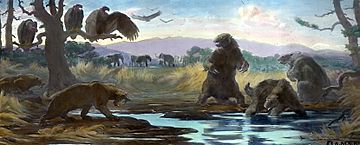
Many incredible prehistoric animals from the Ice Age have been found at La Brea. These include huge Columbian mammoths, fierce dire wolves, giant short-faced bears, powerful American lions, and massive ground sloths. The state fossil of California, the saber-toothed cat (Smilodon fatalis), is also found here.
It's important to remember that you won't find any dinosaur bones here. Dinosaurs died out millions of years before the tar pits even formed!
While big mammal fossils are exciting, scientists also find many other things. These include fossilized insects, plants, and even tiny pollen grains. These smaller fossils help us understand what the climate was like in Los Angeles during the Ice Age. It was much cooler and wetter back then. Scientists use special methods to clean the tar from these tiny fossils and study them under powerful microscopes.
For a long time, people thought the pits mostly trapped meat-eating animals. This was because so many carnivore fossils were found. The idea was that big plant-eaters would get stuck, then meat-eaters would come to eat them and get stuck too. But new studies of tiny fossils show that there were many different kinds of animals, not just carnivores.
Tiny Bacteria at Work
Methane gas bubbles up from the tar pits, making the asphalt look like it's boiling. This gas can even get under nearby buildings. In 2007, scientists discovered that tiny bacteria living in the tar cause these bubbles. These amazing bacteria eat the petroleum and then release methane gas. Researchers have found hundreds of new types of bacteria living in the tar pits!
Signs of Early Humans
Only one human skeleton has been found at La Brea. It belonged to a young woman, about 17 to 25 years old, who lived around 10,000 years ago. She was found near the remains of a domestic dog. Scientists think she might have been buried there on purpose.
Some older saber-toothed cat bones from La Brea show marks that might have been made by tools. These marks are about 15,200 years old. If they are indeed tool marks, it would mean humans were in the Los Angeles area much earlier than we thought. However, it's also possible the tar affected the dating of these bones.
Gallery
-
Skeleton of a Columbian mammoth from the tar pits, displayed in the George C. Page Museum
-
Models of a saber-toothed cat (Smilodon fatalis) and ground sloth on display in 2023
See also
 In Spanish: Pozos de asfalto de La Brea para niños
In Spanish: Pozos de asfalto de La Brea para niños
- Binagadi asphalt lake
- Carpinteria Tar Pits
- Lagerstätten
- List of fossil sites
- Los Angeles County Museum of Art
- McKittrick Tar Pits
- Pitch Lake
- Volcano, a movie about a volcano forming from the La Brea Tar Pits.


